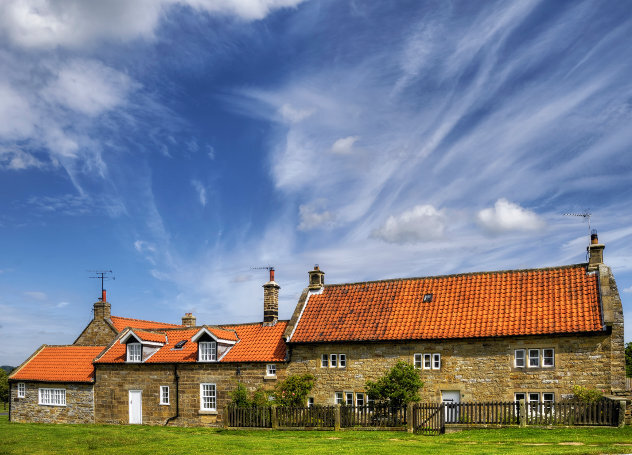The mortgage market in the United Kingdom
Kop-Munt, Tuesday, 18 July 2017

Unrest in the UK mortgage market: the Bank of England is tightening the rules further. Anyone who takes out a mortgage must be able to prove that they can bear the interest burden if the interest rate suddenly rises. This compulsory stress test for homeowners was announced in June of this year. The Bank of England wants to prevent owners from being given a false sense of security now that interest rates are particularly low. Long-term interest rates are exceptional in the United Kingdom. Most mortgage lenders attract their customers with low-interest rates, which rise after a fixed period and then are variable. Almost half of all mortgages are on this so-called Standard Variable Rate (SVR). With the new rules, homeowners will have to demonstrate that they can still bear the mortgage burden if, after the introduction rate, the SVR rises by three percentage points.
This SVR is usually 2 to 5 percentage points above the Bank of England interest rate - since last year 0.25 percent. In the middle of this year, SVR was at 4.56 percent. The Bank of England is expected to raise the interest rate to 0.5 percent at the beginning of next year, according to asset manager Schroders.
Own money needed
The fact that such a large proportion of British homeowners pay a variable interest rate makes the market quite different from the Dutch market. The average Loan-to-value is just under 50 percent. An LTV of more than 90 percent is rare, so homeowners have to take a big bag of money with them. This is particularly challenging for starters, which is why the average age at which British people buy a house for the first time is 30 years. In London, it is even two years higher: home buyers need to bring an average of £96,000 worth of equity capital to acquire a house, according to the British bank Halifax. On average, starters in the UK housing market need £34,000 to be able to qualify for a mortgage at all. To boost home ownership, there are favorable savings schemes with little or no tax on savings, and the government gives £3,000 as a bonus if savings are used to buy a house. Also, composite buy-hire constructions are also available, which give starters the opportunity to purchase the rest of their house at a later time. Of British families (one or two-parent families with one or more children) 51 percent own a private house.
Recovery of British housing market
The British housing market recovered somewhat last month, after a decline due to Brexit. An average British house now costs £ 211,301, which is still 3.5 percent higher than a year ago. In London, the average house price is £636,777, which is just £9,400 lower than a year ago. This is the direct consequence of Brexit: especially the more expensive homes, which are in the center of London and popular with expats, saw their value fall sharply as London loses its appeal. However, mortgage lender Nationwide expects homes to continue to rise 2 percent in value this year because the British are building too little and the shortage on the housing market will not diminish - despite an expected cooling down of the economy.
British mortgages are usually still concluded in person, with long conversations with intermediaries or at the mortgage lenders' offices. The British certainly do not lead the way in reducing red tape and digitization - almost everything has yet to be delivered on paper. Banks are experimenting with Skype conversations, and start-ups are trying to digitize the market, but the percentage of remotely secured mortgages is negligible.
Market partitioning
The largest British mortgage lenders are Lloyds, Santander, Nationwide, Barclays, Royal Bank of Scotland (RBS) and HSBC. The top ten of all mortgage lenders owns about 81 percent of the market. In December, this total market had a volume of £246 billion in outstanding mortgages, an increase of 12 percent compared to December 2015 and the highest amount since 2008.
 This article of is subject to a license. Based on . Translated from the Dutch language by Jos
Deuling.
This article of is subject to a license. Based on . Translated from the Dutch language by Jos
Deuling.

Unrest in the UK mortgage market: the Bank of England is tightening the rules further. Anyone who takes out a mortgage must be able to prove that they can bear the interest burden if the interest rate suddenly rises. This compulsory stress test for homeowners was announced in June of this year. The Bank of England wants to prevent owners from being given a false sense of security now that interest rates are particularly low. Long-term interest rates are exceptional in the United Kingdom. Most mortgage lenders attract their customers with low-interest rates, which rise after a fixed period and then are variable. Almost half of all mortgages are on this so-called Standard Variable Rate (SVR). With the new rules, homeowners will have to demonstrate that they can still bear the mortgage burden if, after the introduction rate, the SVR rises by three percentage points.
This SVR is usually 2 to 5 percentage points above the Bank of England interest rate - since last year 0.25 percent. In the middle of this year, SVR was at 4.56 percent. The Bank of England is expected to raise the interest rate to 0.5 percent at the beginning of next year, according to asset manager Schroders.
Own money needed
The fact that such a large proportion of British homeowners pay a variable interest rate makes the market quite different from the Dutch market. The average Loan-to-value is just under 50 percent. An LTV of more than 90 percent is rare, so homeowners have to take a big bag of money with them. This is particularly challenging for starters, which is why the average age at which British people buy a house for the first time is 30 years. In London, it is even two years higher: home buyers need to bring an average of £96,000 worth of equity capital to acquire a house, according to the British bank Halifax. On average, starters in the UK housing market need £34,000 to be able to qualify for a mortgage at all. To boost home ownership, there are favorable savings schemes with little or no tax on savings, and the government gives £3,000 as a bonus if savings are used to buy a house. Also, composite buy-hire constructions are also available, which give starters the opportunity to purchase the rest of their house at a later time. Of British families (one or two-parent families with one or more children) 51 percent own a private house.
Recovery of British housing market
The British housing market recovered somewhat last month, after a decline due to Brexit. An average British house now costs £ 211,301, which is still 3.5 percent higher than a year ago. In London, the average house price is £636,777, which is just £9,400 lower than a year ago. This is the direct consequence of Brexit: especially the more expensive homes, which are in the center of London and popular with expats, saw their value fall sharply as London loses its appeal. However, mortgage lender Nationwide expects homes to continue to rise 2 percent in value this year because the British are building too little and the shortage on the housing market will not diminish - despite an expected cooling down of the economy.
British mortgages are usually still concluded in person, with long conversations with intermediaries or at the mortgage lenders' offices. The British certainly do not lead the way in reducing red tape and digitization - almost everything has yet to be delivered on paper. Banks are experimenting with Skype conversations, and start-ups are trying to digitize the market, but the percentage of remotely secured mortgages is negligible.
Market partitioning
The largest British mortgage lenders are Lloyds, Santander, Nationwide, Barclays, Royal Bank of Scotland (RBS) and HSBC. The top ten of all mortgage lenders owns about 81 percent of the market. In December, this total market had a volume of £246 billion in outstanding mortgages, an increase of 12 percent compared to December 2015 and the highest amount since 2008.
 This article of is subject to a license. Based on . Translated from the Dutch language by Jos
Deuling.
This article of is subject to a license. Based on . Translated from the Dutch language by Jos
Deuling.

Search for English property and real estate for sale in all regions of England. Houses en farmhouses for sale in London, Greater Manchester, Bedfordshire, Yorkshire and the Humber.
